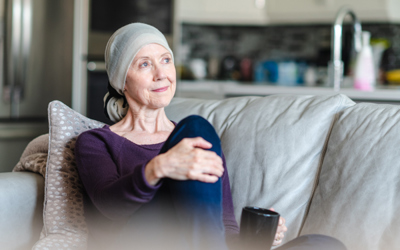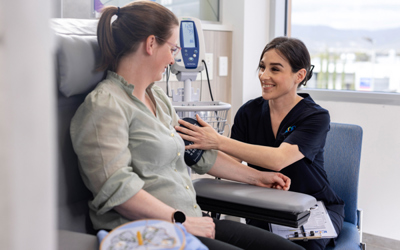What are the treatment options for soft tissue sarcoma?
The primary treatment options for soft tissue sarcoma include surgery, chemotherapy, radiotherapy and targeted therapies. The type of treatment you receive will depend on a number of different considerations, such as the type of soft tissue sarcoma you have, its grade, location and size, your overall health and your treatment preferences. These are often complex decisions and usually made in a multidisciplinary setting with the different specialists involved. This page aims to give you a comprehensive overview of how soft tissue sarcoma treatment works.
Surgery for soft tissue sarcoma
Surgery is often the first step in treating soft tissue sarcoma and, in some cases, may be the only treatment needed. Depending on where your tumour is located, the goal is typically to surgically remove the tumour along with some of the healthy tissue surrounding it.
Surgical options for the treatment of soft tissue sarcoma include:
-
Mohs microsurgery
This procedure involves surgically removing the tumour from the skin in thin layers. Layers of skin will be removed until no cancer cells are detected when viewed through a microscope.
-
Wide local excision
A wide local excision is used to remove sarcoma tumours and some surrounding tissue. Depending on the location of your tumour, you may receive radiation therapy or chemotherapy before surgery to shrink your tumour and make it easier to remove.
-
Limb-salvage surgery
The goal of limb-salvage surgery is to remove all of the cancer and some surrounding tissue while leaving the limb intact.
-
Amputation
During this procedure, all or part of an arm or leg is removed along with the cancerous tumour/s. In cases where the cancer is very large or located in a complicated area, partial or complete amputation may be required. However, amputation is becoming a less common practice with the development of more modern treatment options.
-
Lymphadenectomy
Also referred to as a lymph node dissection, a lymphadenectomy is the surgical process of removing lymph nodes near the tumour that are enlarged and may contain cancer.
Radiotherapy for soft tissue sarcoma
Soft tissue sarcoma patients who are suitable for radiation therapy may receive either external beam radiation therapy or brachytherapy to increase the effectiveness of other treatments. In most cases, radiation therapy is given either before or after surgery as an adjuvant treatment. When delivered before surgery, the goal is to shrink the tumour to make it easier to remove. After surgery, radiation therapy is used to destroy any remaining cancer cells.
External beam radiation therapy
External beam radiotherapy (EBRT) is used to treat soft tissue sarcoma by delivering highly targeted radiation therapy beams to cancerous tumours.
Types of EBRT which can be used for the treatment of soft tissue sarcoma include: Intensity modulated radiotherapy (IMRT).
Brachytherapy
Also known as internal radiation therapy, brachytherapy uses a small radioactive source to treat your soft tissue sarcoma by placing the material inside or near your tumour.
Targeted therapy for soft tissue sarcoma
Targeted therapies use specialised drugs to destroy specific proteins in soft tissue sarcoma cells, while leaving healthy cells intact. These drugs aim to stop soft tissue sarcoma cells from repairing themselves when they get damaged.
Common targeted therapy drugs which are used to treat soft tissue sarcoma include:
Pazopanib - This is a tyrosine kinase inhibitor that works by blocking protein targets on the surface of sarcoma cancer cells, including VEGF (vascular endothelial growth factor growth). By blocking the VEGF protein, the cancer cells no longer get the nutrients they need to grow and spread. It is used to treat soft tissue sarcoma when other treatments have been ineffective and is taken orally as a tablet once daily.
Chemotherapy for soft tissue sarcoma
Chemotherapy uses a range of drugs to kill and slow the growth of soft tissue sarcoma cells. To treat soft tissue sarcoma, chemotherapy may be used as an initial treatment or as an adjuvant treatment after surgery depending on the type and stage of your sarcoma. In some cases, it may also be used as a neoadjuvant treatment to help make the sarcoma easier to remove surgically.
Common chemotherapy medicines
There are a number of different chemotherapy drugs that are used to treat soft tissue sarcoma. These drugs are typically combined based on the type of soft tissue sarcoma you have, its stage and if it has spread. Some of the drugs used include:
-
Doxorubicin
This chemotherapy drug stops the process of DNA replication within cancer cells so that they are unable to grow and spread. It can be used alone as single treatment or in combination with other chemotherapy drugs for advanced or metastatic soft tissue sarcoma. It is typically given by intravenous infusion every 21 days.
-
Ifosfamide
This chemotherapy drug is an alkylating agent that works by damaging the DNA of cells, so that they are unable to divide and grow. It is given by intravenous infusion and may be combined as part of a protocol with doxorubicin.
-
Docetaxel
Docetaxel works by interfering with the function of structures on cells known as the microtubular network, so that cancer cells are unable to multiply and subsequently die. It is used in the treatment of advanced or metastatic soft tissue sarcoma and is given by intravenous infusion every 21 days for around six cycles.
-
Gemcitabine
This is an antimetabolite chemotherapy drug that works by interfering with the DNA synthesis within cancer cells, which stops them from being able to divide and grow. It is given by intravenous infusion every three weeks, typically in combination with docetaxel.
-
Trabectedin
This chemotherapy drug is an alkylating agent that works by binding to cellular DNA, preventing the cells from being able to divide and grow. It is given by continuous intravenous infusion via a pump over 24 hours every 21 days.
Clinical trials for soft tissue sarcoma
Icon offers a wide range of clinical trials providing patients with access to new and evolving treatments. Clinical trials offer hope and opportunity and contribute to breakthroughs in treatment for future cancer patients.

Treatment by stage of soft tissue sarcoma
When you are diagnosed with soft tissue sarcoma, your oncologist will develop your treatment plan as part of a multidisciplinary team based on the stage of your cancer. Most treatment plans for soft tissue sarcoma begin with surgery, however, for sarcomas that are not located in a limb, additional treatment options may be considered first.
Common treatment options for soft tissue sarcoma by stage include:
Stage I soft tissue sarcoma
For early-stage soft tissue sarcoma that is confined to a limb and is less than 5 cm in size, surgery is usually the only treatment needed. In some cases, your doctor may recommend radiotherapy after surgery to ensure no cancer cells remain. If your sarcoma is located anywhere besides a limb, radiotherapy or chemotherapy may be delivered first to shrink the tumour and make it easier to remove.
Stage II and III soft tissue sarcoma
Stage II and III soft tissue sarcoma is typically treated similarly to stage I, however these tumours are often considered high-grade and tend to grow and spread more quickly. During surgery, the tumour and some healthy tissue will be removed including the surrounding lymph nodes. For larger tumours, chemotherapy or radiotherapy may be delivered first to shrink the tumour and make it easier to remove. Depending on factors such as the size and location of the cancer and your overall health, radiotherapy may be used as the primary course of treatment when surgery is not possible.
Stage IV soft tissue sarcoma
Treatment for advanced soft tissue sarcoma begins with surgery to remove as much cancerous tissue as possible. However, stage IV soft tissue sarcoma that has spread to distant parts of the body is considered very difficult to cure and, in many cases, treatment will focus on palliative care to manage your pain and symptoms. Chemotherapy, radiotherapy and targeted therapies may be used to relieve symptoms of your cancer.









